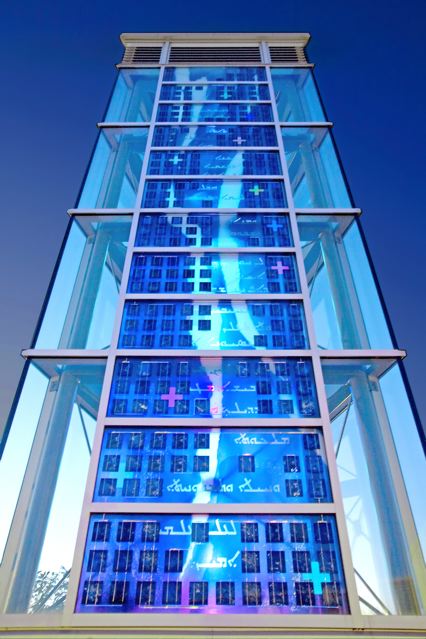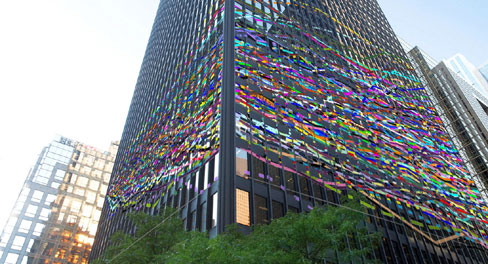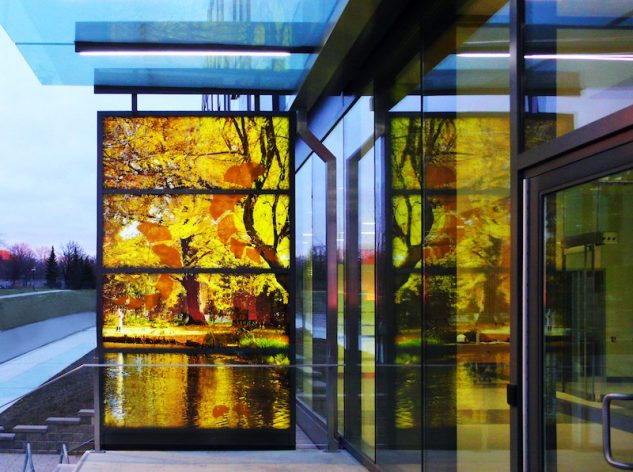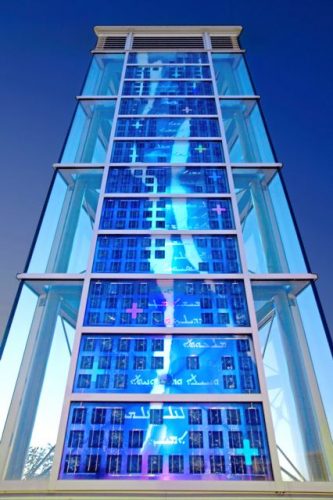The Modern Masterpieces of Sarah Hall:
Art Glass For the Planet

There is no doubt that Sarah Hall’s work holds its own against the best of Canadian art glass; from the shimmering, twisting blues of her panels at B.C.’s Regent College, to the vivid golden-umber autumn scene placed outside York University in Toronto, to the numerous facades flooding religious institutions around North America with light, grace, and glory, her work lifts the observer to a place of spiritual reverence.
But something more than sheer beauty sets Sarah Hall’s work apart; her creations are no mere exercise in functionless aesthetics, no idle bystanders sitting decoratively in the background of human existence—instead, this is Canadian art glass with a purpose. The vast majority of Hall’s work has been crafted with the aim of nurturing the fragile environment around it.
Prairie Fire
Rising abruptly from the windswept grasses of Canada’s Great Plains region, Saskatchewan’s Lux Gloria cathedral routinely shatters the cool murk of twilight and the pale hush of dawn with its vividly smouldering stained glass windows. Moving from hues of deep purple to orange so electric it looks alive, Sarah Hall’s installations seem to have captured the soul of the famous “big sky” sunsets that kiss the tall white cathedral each evening.
But the sun is not merely something these windows embody or reflect—it is something they transmute. Each of the great panels contains a number of cleverly concealed solar cells that produce electricity the cathedral can actually use, making the Lux Gloria the proud home of what is likely the world’s first solar stained glass windows.

The impact has not been solely practical; in the proud tradition of using art to draw attention to a cause, Sarah Hall’s windows have capitalised on their allure to church-goers and passers-by, helping to generate awareness about solar power in a province notorious for its energy use and carbon emissions. (Saskatchewan residents use more energy and produce more greenhouse gas emissions per capita than anywhere else in Canada, largely owing to the impact of the oil and gas industry.)
“I think there is some wonderful potential in moving ahead, making renewables beautiful and making them integrate into our daily architecture,” Hall says of her work’s mission. Her inspiration to make this leap? Her own past tendency to combine modern, geometric structures with natural elements when creating art glass. Incorporating modern needs and concerns, in the form of solar cells, simply seemed like the logical next step. To Hall, and to many of her fans, that no other artist in North America appears to be doing the same is more surprising than the fact that she thought to do so.
The mantra that guides her when creating these wonderfully practical works of art is simple: Every little bit helps. “If I can have people look at [my work] and be engaged, and do something beautiful for my clients, who gather energy through their installations, then that makes a little bit of a contribution.”

Flying Free
Alternative energy is not the only cause furthered by Hall’s creations; our feathered friends are also befitting greatly from her contributions to the world of Canadian art glass.
If you have ever been to Toronto, you know that it is a resplendent city to behold, with its shining towers proclaiming the best of Canada’s wealth, progress, and cosmopolitan flair. Alas, as stunning as all of that glass is to look at—as if reflects the vast waters of Lake Ontario, the sky above, and the bustle below—it poses a real danger for the bird life that passes through the city each year. According to a 2013 Environment Canada study, collisions with houses and buildings result in about 25 million bird deaths a year, a significant threat to Canada’s wealth of endemic and migratory species.
This issue first came to Sarah’s attention when she was speaking with a group of architects about applying an entire painted solar facade to a building, and they said that it “Would really solve some of the problems with bird strikes.” Intrigued, Sarah started reading about avian impacts and was “absolutely staggered” by the numbers—of the 25 million birds felled annually in Canada, about 10 million were dying in Toronto. Something had to be done.
Hall knew the task would not be easy; “One of the problems with bringing regular solar cells into large facades is that they’re not transparent,” she explains. Thankfully, innovation came to the rescue: “New work is being done with semi-transparent and coloured cells that are being made with nanotechnology. I thought that if I used that new type of glass and brought some art to it, something that would make it interesting, then we’d have a facade that birds won’t fly into, that people can see out of and that will generate electricity for the building. When people think solar, they think of something on the roof that doesn’t have any design aesthetic. But it can be the walls of a building, and it can be beautiful.”
Her idea soon caught on; Hall was awarded an Ontario Arts Council grant for an 18-month research project, enabling her to see her revolutionary idea through to fruition. To get the kind of glass she needs, she will have to head all the way over to the UK and partner with Oxford Photovoltaics. “They’ll be pushed a little bit to do this at the size I want, but they’re already making the glass at a smaller scale and combining it with some of my artwork.”
For Sarah, it’s a labour of love; “I want to connect with people and get them excited about the idea. If we can have a building that helps take care of the environment and is friendlier to our fellow creatures, we’re going to have a better place.”

